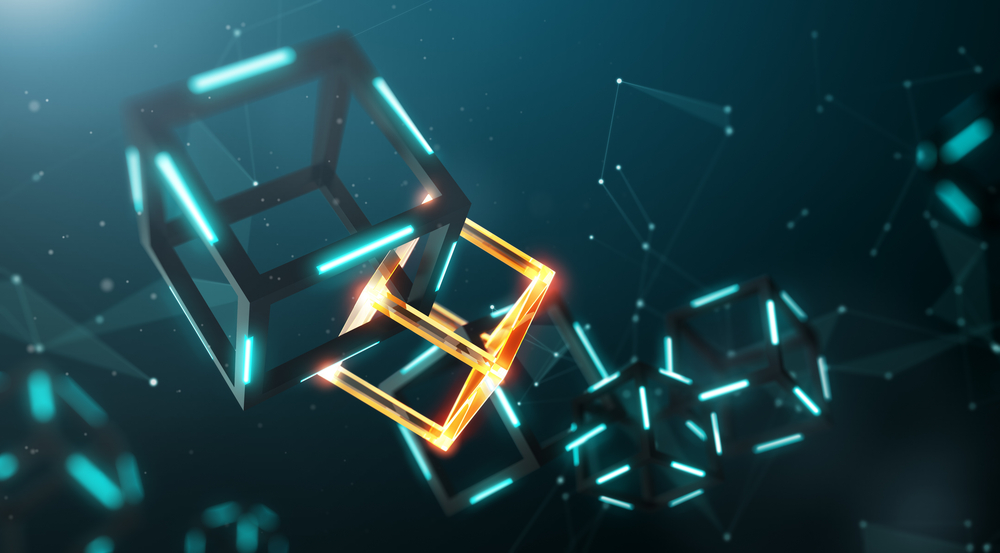Blockchain: What Is It, How Does It Work, and How Is It Changing the World?

Most people have heard of the blockchain, but very few actually know what it means. When you ask someone what it is, they’re likely going to spew out a bunch of words and phrases that won’t make any sense. Or the explanation will take so long that you lose interest in it.
The simplest way to explain it is that it’s a reliable, very difficult to hack record of transactions and who owns what. Blockchain is based on distributed ledger technology which securely records information across peer-to-peer networks. It was initially created to trade the cryptocurrency Bitcoin, but its potential reaches far beyond cryptocurrency.
Blockchain ledgers can include titles, loans, identities, and almost anything else of value. The technology is still very new, but the potential impact it can have on business and everyday life is enormous.
94 Out of The Top 100 Projects Are Built on Ethereum
With all of these projects coming out, there has to be a network that is supporting them. In most cases, that network is Ethereum.
The Ethereum community already has more than 250,000 developers and 94 out of the top 100 blockchain projects have launched on top of the Ethereum network. Ethereum’s development framework called Truffle already has more than 500,000 downloads and development interests have continued to rise.
The vast majority of cryptocurrencies and tokens apart from payment-focused blockchain networks are built on top of the Ethereum protocol. Even Tron, the 10th largest cryptocurrency in the global market with a market valuation of $3.4 billion, is built on the ERC20 token standard of Ethereum.
$2 billion China-based IoT blockchain network VeChain, $1 billion high-performance blockchain Ontology, $900 million South Korea-based ICON, and $850 million Sharding-focused blockchain project Zilliqa are a few examples of major blockchain projects that currently exist on the Ethereum network.
The Blockchain Project Ecosystem

A blockchain project is simply a project that looks to take advantage of the blockchain. Due to the rise of bitcoin technologies, a large number of teams and companies are building decentralized projects seeking to take advantage of the most valuable property of blockchains, which is the ability to reach a shared truth that everyone agrees on without intermediaries or centralized authority.
There are a countless number of exciting developments coming to market that will improve existing blockchain functionality as well as the consumer’s experience. Because of the rapid pace at which projects are coming to market, however, it can be difficult to keep track of each and every project and where each one fits into the blockchain project ecosystem.
There are several categories each project will fit into. Some projects can fit into more than one category, but they are listed with the category that fits their main purpose the best. Below we will take a look at what each category is and what they do.
Currencies
Currency projects are built with the intention of building better currencies for various uses and represent a store of value, medium of exchange, or a unit of account.
You’ve probably heard of Bitcoin because it was the first and most prominent project in this category. Many of the other currency projects set out to improve upon a certain aspect of Bitcoins protocol or tailor it to a specific use.
Developer Tools
Projects in the developer tools category are used as the building blocks for decentralized applications. To allow users to directly interact with protocols through application interfaces, most of the current designs in this category need to be proven at scale.
In order for many of the projects in this category to come to fruition foundational, scalable infrastructure needs to grow and mature.
Fintech
This category is fairly straightforward. When you’re interacting with a number of different protocols and applications (such as in the Developer Tools example above), many may have their own native cryptocurrency, and thus a number of new economies emerge.
In an economy with multiple currencies, there’s a need for tools for exchanging one unit of currency for another, facilitating lending, accepting investment, etc. That’s where the projects in the Fintech/DEX category come in.
Sovereignty
The projects in this category provide the functionality necessary for a world where users aren’t forced to trust in any individual or organization but rather in the incentives implemented through cryptography and economics.
Value Exchange
Today, middlemen and rent seekers are a necessary evil in order to keep order, maintain safety, and enforce the rules of P2P marketplaces. But in many areas, these crypto economic systems can replace that trust, and cutting out middlemen and their fees will allow users to exchange goods and services at a significantly lower cost.
Shared Data
The projects in the shared data category are similar to the airline industry’s Global Distribution Systems (GDS’s). GDS’s are a centralized data warehouse where all of the airlines push their inventory data in order to best coordinate all supply information, including routes and pricing.
This allows aggregators like Expedia and Priceline and other companies in the space to displace traditional travel agents by building a front end on top of these systems that users can transact on.
Authenticity
Cryptocurrencies digital assets native to a specific blockchain and projects in the authenticity category are using these digital assets to represent either real-world goods or data.
The immutability of public blockchains allows network participants to be confident in the fact that the data written to them hasn’t been tampered with or changed in any way and that it will be available and accessible far into the future.
Four Blockchain Projects Solving Real-World Problems

So what does this all mean for the people who aren’t really interested in the technology? What is it doing for people outside of the technology industry? Here are four blockchain projects that are solving real-world problems.
Robonomics
Robonomics is an Ethereum network infrastructure for the integration of robotic factories into smart cities and Industry 4.0. Robonomics allows autonomous robots to cooperate with one another in order to make economic decisions without human intervention.
The network’s purpose is to distribute, control and provide services using cyber-physical systems. Robonomics Network is adaptable to human needs, built on the basis of existing market mechanisms and is directly accessible to the end user.
By expanding the capabilities of the basic communication protocol, robots are able to interact with market mechanisms and contractual obligations. As such, the platform provides tools for designers of new cities and industrial zones to provide direct user access for ordering products from autonomous factories directly.
Cyclebit
Most merchants still don’t accept cryptocurrency due to the lack of easily-customizable payment infrastructure, the volatility of cryptocurrencies, and their inability to be used in fast microtransactions.
Cyclebit believes massive price fluctuations could be mitigated by widespread ownership and usage, facilitated by providing easy ways to pay with cryptocurrency. The startup has a solution which allows any point of sale to install an iOS and/or Android-supported application running to receive digital currencies. The app facilitates payments from online crypto wallets as well as those from old-fashioned banks.
Cyclebit is being deployed across 130 Nostrum coffee shops throughout Spain where customers can pay in BTC. The startup already has access to a working ecosystem provided by Ibox – an omnichannel payment platform with 200,000 point-of-sales earmarked for imminent roll-out.
IOTW
IOTW is an IoT blockchain infrastructure characterized by instantaneous throughput achieved by Proof of Assignment protocol. It enables micro-mining and instant transactions on all connected devices without any extra hardware, thus bringing blockchain to household industry and business.
Proof of Assignment makes the network leaner and faster – hence making it more suitable for IoT devices – and eliminates the centralization problems faced under Proof of Stake.
The product has been tested on over 1,000 IoT devices running on a single trusted node on the blockchain. Current transaction speed tests have shown results of 3,000 transactions per second (tx/s) for long distance transactions and 100,000 tx/s for local ones.
TrustVerse
Trustverse is personal wealth and digital asset management platform designed around the use of the blockchain and artificial intelligence. It is a deep-learning based digital assistant for almost every facet of digital holdings. The platform provides a reliable smart contract system that simplifies legacy planning, inheritance organization, and the transfer of digital assets. It works as a one-stop shop for everything people need: from managing their portfolios, taxes, identities to distributing their assets after death.
Unlike traditional financial services where a particular organization stores customer personal data on a centralized server, TrustVerse does not store any personal data. Instead, it provides services to users authenticated by a technology jointly developed with Microsoft.
Get to Know Blockchain

While still relatively new, and widely misunderstood, blockchain technology is set to revolutionize the way we do everything. It’s good to get a basic understanding of the ecosystem and the projects taking place right now, so you’re ahead of the curve mainstream. In a decade or so, the blockchain will likely be a part of our everyday lives.
Resources:
- https://techcrunch.com/2017/10/16/mapping-the-blockchain-project-ecosystem/
- https://cointelegraph.com/news/south-korea-to-triple-the-budget-for-blockchain-projects-compared-to-2018
- https://cointelegraph.com/news/apples-steve-wozniak-plans-to-get-involved-in-blockchain-project-for-first-time
- https://www.reuters.com/article/us-banks-fintech-blockchain-idUSKBN1H32GO
- https://cointelegraph.com/news/which-countries-are-best-to-start-blockchain-projects
- https://cointelegraph.com/news/belgium-contributes-to-world-food-programme-blockchain-project
- https://cointelegraph.com/news/australian-government-awards-grant-to-blockchain-project-for-sustainable-sugar
- https://techcrunch.com/2018/01/28/bank-based-blockchain-projects-are-going-to-transform-the-financial-services-industry/
- https://www.forbes.com/sites/rachelwolfson/2018/12/14/binance-labs-launches-8-blockchain-projects-to-solve-the-industrys-biggest-challenges/
- https://www.ccn.com/swiss-regulator-grants-first-ever-banking-licenses-to-2-blockchain-firms/
- https://cointelegraph.com/news/ibm-and-salon-media-pilot-blockchain-solution-for-digital-ad-transparency
- https://www.coindesk.com/markets/2018/10/18/gates-foundation-partners-with-former-ripple-ctos-blockchain-project/
- https://www.coindesk.com/markets/2018/08/30/8-blockchain-projects-enlist-early-to-test-secret-enigma-contracts/
- https://thenextweb.com/news/microsoft-and-ey-launch-blockchain-for-copyrights-and-royalties
 Castings & Forgings
Castings & Forgings
 Bulk Material Handling
Bulk Material Handling
 Electrical & Electronic Components
Electrical & Electronic Components
 Flow Instrumentation
Flow Instrumentation
 Hardware
Hardware
 Material Handling Equipment
Material Handling Equipment
 Metal Cutting Services
Metal Cutting Services
 Metal Forming Services
Metal Forming Services
 Metal Suppliers
Metal Suppliers
 Motion Control Products
Motion Control Products
 Plant & Facility Equipment
Plant & Facility Equipment
 Plant & Facility Supplies
Plant & Facility Supplies
 Plastic Molding Processes
Plastic Molding Processes
 Pumps & Valves
Pumps & Valves
 Recycling Equipment
Recycling Equipment
 Rubber Products & Services
Rubber Products & Services